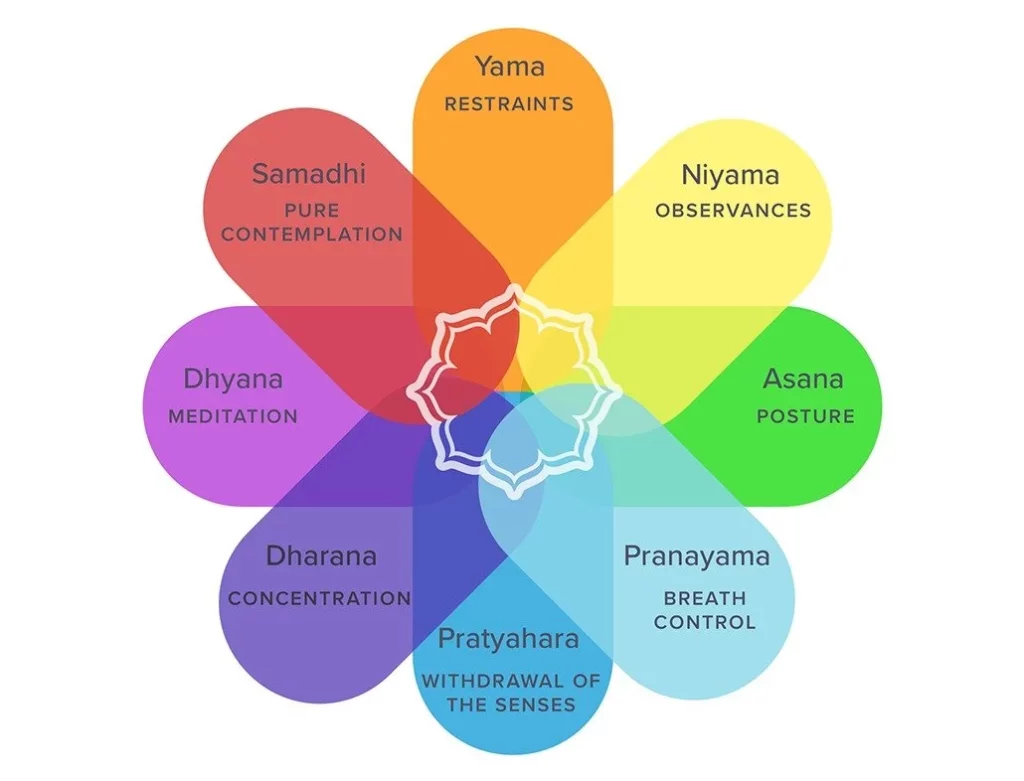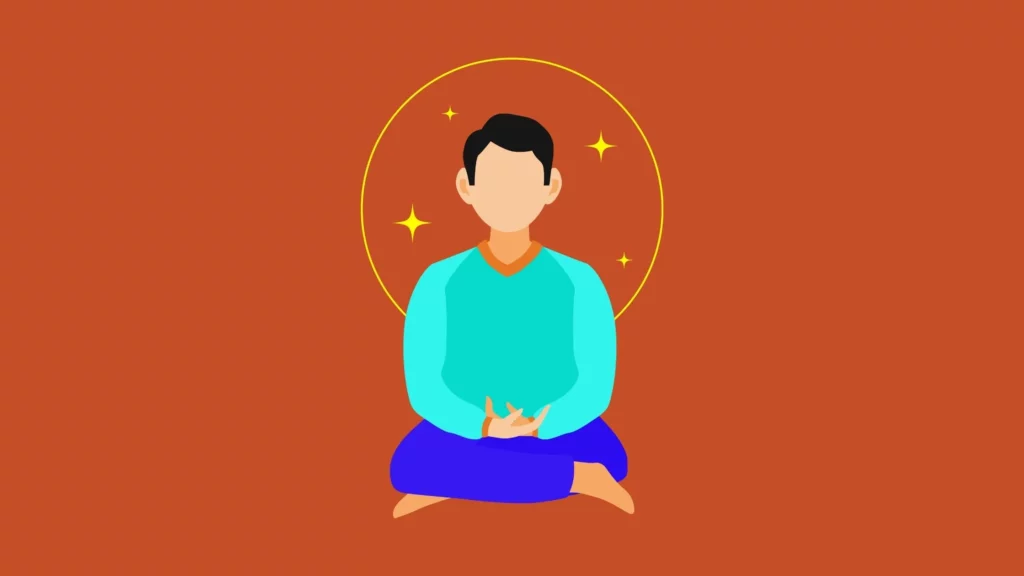What is Ashtanga Yoga?
What is ashtanga yoga? The word ‘Ashtanga’ is a combination of two words Ashta meaning ‘Eight’ and Anga meaning ‘Limbs’. As per Maharishi Patanjali, there are eight limbs of yoga. It is a way by which a person can lead to ultimate peace and happiness. It is a way of living life. Ashtanga Yoga can lead to personal and social harmony, physical health, intellectual awakening, peace of mind, and spiritual bliss. No one can become a yogi unless he/she follows ashtanga yoga. This is not only for Yogis or Yogins but whoever wants to be happy in life needs to follow this path. Limbs of Yoga or Stages of Yoga are alternate names for Ashtanga Yoga. In this article, we will see about these stages and how they are going to impact our lives for good.
Following are the eight stages of yoga.

1. Yama (Universal Moral Commandments)
2. Niyama (Self-purification by discipline)
3. Asana (Posture)
4. Pranayama (Rhythmic control of the breath)
5. Pratyahara (Withdrawal and emancipation of the mind from the domination of the senses and exterior objects)
6. Dhaarana (Concentration)
7. Dhyana (Meditation) and
8. Samaadhi (A state of super-consciousness brought about by profound meditation, in which the individual aspirant (sadhaka) becomes one with the object of his meditation- Paramatma or the Universal Spirit).
Let’s see what each one of these limbs means.
1. Yama:
This is the first limb of yoga. Yama refers to ethical disciplines – the great commandments transcending creed, country, age, and time. They are ahimsa, satya, asteya, brahmacharya, and aparigraha. These commandments are the rules of morality for society and the individual.
Ahimsa:
The word ahimsa comprises the particle ‘a‘ meaning ‘not’ and the noun ‘himsa’ meaning killing or violence. It is more than a negative command not to kill, for it has a wider positive meaning, love. This love embraces all creation for we are all children of the same Father- the Lord. The yogi believes that every creature has as much right to live as he has. He believes that he is born to help others and he looks upon creation with eyes of love.
Satya:
Satya or truth is the highest rule of conduct or morality. Mahatma Gandhi said: ‘Truth is God and God is Truth’. As the fire burns impurities and refines gold, the fire of truth cleanses the yogi and burns up the dross in him.
Asteya:
The desire to possess and enjoy what another has drives a person to do evil deeds. From this desire springs the urge to steal and the urge to covet. Asteya (a= not, steya=stealing), or non-stealing includes not only taking what belongs to another without permission, but also using something for a different purpose than that intended, or beyond the time permitted by its owner.
Brahmacharya:
According to the dictionary, brahmacharya means a life of celibacy, religious study, and self-restraint. This does not mean that the philosophy of Yoga is meant only for celibates. Brahmacharya has little to do with whether one is a bachelor or married and living the life of a householder. One has to translate the higher aspects of Brahmacharya into one’s daily living.
Aparigraha:
Parigraha means hoarding or collecting. To be free from hoarding is aparigraha. It is thus but another facet of asteya (nonstealing). Just as one should not take things one does not need, one should not hoard or collect things one does not require immediately. Neither should one take anything without working for it or as a favor from another.
2. Niyama:
Niyama are the rules of conduct that apply to individual discipline, while Yama are universal in their application. The five Niyama listed by Patanjali are saucha, santosha, tapas, svadhyaya, and Ishwara pranidhana.
Saucha:
Saucha means Purity. The purity of the body is essential for well-being. But more important than the physical cleansing of the body is the cleansing of the mind of its disturbing emotions like hatred, passion, anger, lust, greed, delusion, and pride. Besides Physical and mental purity, pure food is also necessary. Apart from cleanliness in the preparation of the food, it is necessary to observe purity in the means by which one procures it.
Santosha:
Sanotsha means contentment or a state of happiness and satisfaction. A mind that is not content cannot concentrate. The yogi feels the lack of nothing and so he is naturally content. You have to cultivate Santosha or contentment while practicing yoga.
Tapas:
Tapas means Ardour i.e. having great enthusiasm and passion. The word ‘Tapas’ is derived from the root ‘tap’. ‘Tap’ means to blaze, burn, shine, suffer pain, or be consumed by heat. It, therefore, means a burning effort under all circumstances to achieve a definite goal in life. It involves purification, self-discipline, and austerity.
Svadhyaya:
Sva means self and adhyaya means to study or education. Education is the drawing out of the best that is within a person. Svadhyaya, therefore, is the education of the self. The person practicing svadhyaya reads his own book of life, at the same time that he writes and revises it. There is a change in his outlook on life.
Ishwara pranidhana:
Ishwar pranidhana means having a dedication to the lord. Dedication to the Lord of one’s actions and will is Ishwar pranidhana. He who has faith in God does not despair, He has illumination (Tejas) and knows that all creation belongs to the Lord and will not be puffed up with pride or drunk with power. He will not stoop for selfish purposes; his head will bow only in worship.
3. Asana:
The third limb of yoga is asana or posture. Asana brings steadiness, health, and lightness to limbs. A steady and pleasant posture not only produces physical equilibrium but also prevents fickleness of the mind. To perform the asanas one needs a clean airy place, a blanket, and determination. Asanas without the other limbs Yama, Niyama is mere acrobatics.
4. Pranayama:
Just as the word yoga is one of wide import, so also is prana. Prana means breath, respiration, life, vitality, wind, energy, or strength. It also connotes the soul as opposed to the body. The word prana is generally used to indicate vital breaths. Ayama means length, expansion, stretching, or restraint. Pranayama thus connotes the extension of breath and its control. There are innumerable benefits of Pranayama.
You might be wondering; how controlling breath can affect our body? Let’s understand with a simple example. Let us assume two persons are provided with the same set of colors, brushes, and paper. One is an excellent painter and the other is not so into painting. What do you think, whose painting will be better? The first person’s painting will be a lot better. What did make him different from the latter? The practice, and ability to use tools at hand responsibly and consciously. In the same way, every living body breathes, but the ones who use it consciously and responsibly are living masterpieces.
5. Pratyahara:
If a man’s reason succumbs to the pull of his senses, he is lost. On the other hand, if there is rhythmic control of breath, the senses instead of running after external objects of desire turn inwards, and the man is set free from their tyranny. To conclude, the fifth stage of Yoga, namely, pratyahara, brings the senses under control.
6. Dharana:
When the body has been tempered by asanas, when the mind has been refined by the fire of pranayama, and when the senses have been brought under control by pratyahara, the sadhaka reaches the sixth stage called Dharana. Here he is concentrated wholly on a single point or on a task in which he is completely engrossed. The mind has to be stilled to achieve this state of complete absorption.
The mind is an instrument that classifies, judges, and coordinates the impressions from the outside world and those that arise within oneself. Mind is the product of thoughts that are difficult to restrain for they are subtle and fickle. So a thought that is well guarded by a controlled mind brings happiness.
7. Dhyana
When oil is poured from one vessel to another, one can observe a steady constant flow. When the flow of concentration is uninterrupted, the state that arises is dhyana (meditation). As the filament in an electric bulb glows and illumines when there is a regular uninterrupted current of electricity. Similarly, dhyana illuminates the Yogi’s mind. His body, breath, senses, mind, reason, and ego are all integrated into the object of his contemplation- the Universal Spirit. He remains in a state of consciousness that has no qualification whatsoever.
8. Samaadhi:
Samaadhi is the end of the sadhaka’s quest. At the peak of his meditation, he passes into the state of samadhi, where his body and senses are at rest as if he is asleep, his faculties of mind and reason are alert as if he is awake, yet he has gone beyond consciousness. The person in a state of samadhi is fully conscious and alert.

Conclusion:
To conclude, Ashtanga Yoga is the way to lead a healthy and peaceful life. The primary goal of Ashtanga yoga is to develop a strong foundation in the practice of Yogasanas. The steps in Ashtanga yoga are designed to work the entire body and to challenge the practitioner physically and mentally. To maximize the benefits of Ashtanga yoga, it is important to adhere to a consistent practice.
To read more about yoga, see yogtastic.
